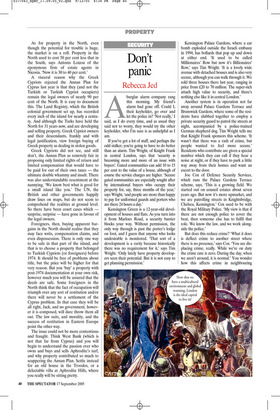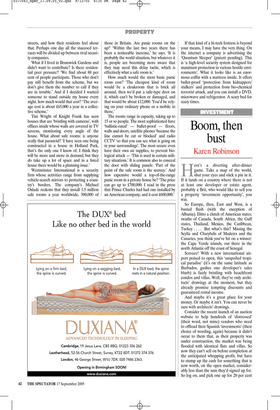Don’t panic
Rebecca Jed
Aburglar alarm company rang this morning. My friend’s alarm had gone off. Could I, their keyholder, go over and let the police in? ‘Not really,’ I said, as I do every time, and as usual they said not to worry, they would try the other keyholder, who I’m sure is as unhelpful as I am.
If you’ve got a lot of stuff, and perhaps the odd stalker, you’re going to have to do better than an alarm. Tim Wright, of Knight Frank in central London, says that ‘security is becoming more and more of an issue with buyers’. Gated communities can add 10 to 15 per cent to the value of a house, although of course the service charges are higher. ‘Secure gated communities are especially sought after by international buyers who occupy their property for, say, three months of the year,’ says Wright, ‘and people are more than happy to pay for uniformed guards and porters who are there 24 hours a day.’ Kensington Green is a 12-year-old development of houses and flats. As you turn into it from Marloes Road, a security barrier blocks your way. Without permission, the only way through is past the porter’s lodge on foot, and I guess that anyone who looks undesirable is monitored. ‘That sort of a development is a rarity because historically there was no requirement for it,’ says Tim Wright. ‘Only lately have property developers seen their potential. But it is not easy to get planning permission.’ Kensington Palace Gardens, where a car bomb exploded outside the Israeli embassy in 1994, has bollards that pop up and down at either end. ‘It used to be called Millionaires’ Row but now it’s Billionaires’ Row,’ says Tim Wright. ‘It is a lovely wide avenue with detached houses and is also very secure, although you can walk through it. We sold three houses there last year, ranging in price from £20 to 70 million. The super-rich attach high value to security, and there’s nothing else like it in central London.’ Another system is in operation not far away around Palace Gardens Terrace and Brunswick Gardens, where some of the residents have clubbed together to employ a private security guard to patrol the streets at night, accompanied by a police-trained German shepherd dog. Tim Wright tells me that Knight Frank sponsors this scheme. ‘It wasn’t that there was a rash of crime, but people wanted to feel more secure.’ Residents who contribute are given a special number which they can call if they hear a noise at night, or if they have to park a little way away from their homes and want an escort to the door.
Joe Cox of Defence Security Services, which runs the Palace Gardens Terrace scheme, says, ‘This is a growing field. We started out on council estates about seven years ago. But now it’s more upmarket, and we are patrolling streets in Knightsbridge, Chelsea, Kensington.’ Cox used to be with the Royal Military Police. ‘My view is that if there are not enough police to cover the beat, then someone else has to fulfil that role. We know the law, and we work alongside the police.’ But does this reduce crime? ‘What it does is deflect crime to another street where there is no presence,’ says Cox. ‘You are displacing crime, really. While we’re on duty the crime rate is zero. During the day, when we aren’t around, it is normal.’ You wonder how this affects crime in neighbouring streets, and how their residents feel about that. Perhaps one day all the stuccoed terraces will be divided up between rival security companies.
What if I lived in Brunswick Gardens and didn’t want to contribute? Is there residential peer pressure? ‘We find about 88 per cent of people participate. Those who don’t pay still benefit from the scheme, but we don’t give them the number to call if they are in trouble.’ And if I decided I wanted someone to stand outside my house every night; how much would that cost? ‘The average cost is about £65,000 a year in a collective scheme.’ Tim Wright of Knight Frank has seen houses that are ‘bristling with cameras’, with offices inside whose walls are covered in TV screens, monitoring every angle of the house. What about safe rooms: is anyone really that paranoid? ‘I have seen one being constructed in a house in Holland Park, that’s the only one I know of. I think they will be more and more in demand, but they do take up a lot of space and in a listed house there would be a planning issue.’ Westminster International is a security firm whose activities range from supplying vehicle-search mirrors to protecting a country’s borders. The company’s Michael Oxlade reckons that they install 1.5 million safe rooms a year worldwide, 500,000 of those in Britain. Are panic rooms on the up? ‘Within the last two years there has been a noticeable increase,’ he says. ‘It is probably the world situation, but whatever it is, people are becoming more aware that they may need this delay tactic, which is effectively what a safe room is.’ How much would the most basic panic room cost? ‘The cheapest kind of room would be a cloakroom that is brick all around, then we’d put a safe-type door on it, which can’t be broken or damaged, and that would be about £12,000. You’d be relying on your ordinary phone or a mobile in there.’ The rooms range in capacity, taking up to 15 or so people. The most sophisticated have ‘ballistic-rated’ — bullet-proof — floors, walls and doors, satellite phones ‘because the line cannot be cut or blocked’ and radio CCTV ‘so that you can see what is going on in your surroundings’. The most secure even have their own air supplies, to prevent biological attack — ‘This is used in certain military situations.’ It is common also to conceal the door with sliding panels: ‘Part of the point of the safe room is the secrecy.’ And how expensive would a top-of-the-range panic room in a private house be? ‘The price can go up to £700,000. I read in the press that Prince Charles had had one installed by an American company, and it cost £600,000.’ If that kind of a hi-tech fortress is beyond your means, I may have the very thing. On the internet a company is advertising the ‘Quantum Sleeper’ (patent pending). This is ‘a high-level security system designed for maximum protection in various hostile environments’. What it looks like is an enormous coffin with a mattress inside. It offers bullet-proof ‘protection from kidnappers/ stalkers’ and protection from bio-chemical terrorist attack, and you can install a DVD, microwave and refrigerator. A scary bed for scary times.




















































 Previous page
Previous page